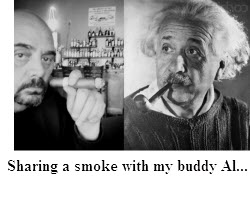I’ve seen this gambit so many times in my industry. Someone will put together a post on how to design incentive programs and they want to sound really smart so they sidle up to some scientific “evidence” to convince you they know how to create the best motivation program ever. Don’t get me  wrong – you should use the science that’s available. But let’s not let someone get away with “intelligence by proximity” or as I like to say – “Standing next to Einstein” and hoping the buyer can’t tell the difference between them and a real thought leader.
wrong – you should use the science that’s available. But let’s not let someone get away with “intelligence by proximity” or as I like to say – “Standing next to Einstein” and hoping the buyer can’t tell the difference between them and a real thought leader.
Or in the case of this post on Incentive Magazine – standing next to B.F. Skinner.
This post, called “Designing Employee Reinforcement” written by an Exec from one of the larger incentive suppliers ran 8 years ago. And it is still as wrong today as it was then. Pulling from that post:
“We need to adjust our thinking about how we compensate and motivate our workforces. In short, we need to inspire our people in ways that are both effective and affordable.
A good way to start is to think less about rewarding results and more about reinforcement of positive behaviors required to produce the results. This is a simple and effective methodology that, when deployed properly, can create a positive and enthusiastic work environment.”
I am in 100% agreement with those two paragraphs. Focus on behavior and look at ways to make the environment positive.
Then the author goes insane.
I AM NOT AN ANIMAL!
The article jumps from a good intro to a discussion on the concepts of operant conditioning.
Specifically, the various reinforcement schedules studied by B.F. Skinner in the late 1930’s and further refined through the 50’s and into the 70’s. If you have spent any time reviewing Skinner’s work, you know this… Skinner really did not believe in free will.
Watch the first minute of this video on conditioning featuring an interview with Skinner. Pay attention to the comments made 26 seconds into the video… (email/rss readers will have to click through to the post to see video.)
Here’s the important piece of information…
“So, the pigeon isn’t acting independently. Its behavior is shaped by its environment.”
The extension of this line of thinking is:
“…the best program design for engagement is a program where your employees aren’t thinking independently.”
Let me ask this simple question? Do you really think applying operant conditioning to employees is the best way to get employees “inspired” and focused on creating a “positive and enthusiastic environment”?
Standing Next To, Isn’t Being
This article is simply a trick to make you think that because an incentive supplier quotes a famous scientist about behavior, they know what they are talking about. Standing next to Skinner doesn’t make you right.
 I quote a lot of studies and scientific stuff, and in most cases, I will admit if I’m not sure they apply to program design. I’m always looking for ways to help companies increase the odds of influencing behavior ethically and in a way that benefits both the employee, the channel audience AND the company. So, I bring up ideas and thoughts based on those studies. I don’t think I’ve ever recommended that you condition employees (can you say “A Clockwork Orange?”) I’ll be the first one to tell you that the studies are directional – not dictatorial.
I quote a lot of studies and scientific stuff, and in most cases, I will admit if I’m not sure they apply to program design. I’m always looking for ways to help companies increase the odds of influencing behavior ethically and in a way that benefits both the employee, the channel audience AND the company. So, I bring up ideas and thoughts based on those studies. I don’t think I’ve ever recommended that you condition employees (can you say “A Clockwork Orange?”) I’ll be the first one to tell you that the studies are directional – not dictatorial.
Studies and theories are simply jumping off points to help you determine how to best align your goals and your employees.
If you buy the idea that the best way to engage employees is through rote behavioral conditioning than you deserve the program you get – and you deserve the long-term employee problems you will experience.
Engagement Isn’t Conditioning
This article is not only demeaning to those that are in the incentive program, it’s demeaning to buyers of incentive programs and frankly – continues to position those in the industry as snake oil salespeople that will do anything to sell a toaster or a trip.
Quality incentive, reward, recognition and influence programs signal the behaviors your company values and the behaviors you want the audience to do. Properly designed incentive programs communicate direction and allow employees to choose to play and be rewarded. At their core, incentives are simply choice architectures. People have to CHOOSE to play.
Operant conditioning can and will drive a behavior. And that’s great if you want the dog to stay in the yard or get your employees to turn off their computers. However, if you want thinking, engaged, challenging, happy, innovative and ethical employees – this isn’t the right path.
Podcast Link
 You may remember one of my first podcasts was called “Calling BS on The Experts In Engagement, Motivation and Rewards” – where I interviewed Mike Haberman (@MikeHaberman) lead consultant and owner of Omega HR Solutions. Mike was just shy of getting his Ph.D. in behavioral psychology or some such thing before deciding HR was more interesting. Maybe? Either way – click out here to read the original post and listen to the podcast. He’s on board with me… operate conditioning isn’t how this should be done. Ever.
You may remember one of my first podcasts was called “Calling BS on The Experts In Engagement, Motivation and Rewards” – where I interviewed Mike Haberman (@MikeHaberman) lead consultant and owner of Omega HR Solutions. Mike was just shy of getting his Ph.D. in behavioral psychology or some such thing before deciding HR was more interesting. Maybe? Either way – click out here to read the original post and listen to the podcast. He’s on board with me… operate conditioning isn’t how this should be done. Ever.
And bonus – you’ll get a great quote on “mango-bloated monkeys.” And an “Office” clip you’ll enjoy!
Forget the “conditioning” and worry about the “conditions”
Spend time finding out what is needed to get employees to WANT to contribute versus listening to this garbage about conditioning your employees like pigeons and rats. The last thing most companies need is a bunch of drones – pecking away at a dot in order to get a morsel of food or another crystal vase.
I don’t believe operant condition – no matter if it is effective or not – is a strategy you should EVER consider. And frankly – I don’t think it will work anyway. We have free will. We have the ability to understand context and we can tell (usually) when we’re being manipulated. And when we smell manipulation – we start looking for a way out of that rat’s maze.
Don’t assume because someone is standing next to Einstein they are as smart as him.
Just approach your program participants ethically and honestly.
That’s what they really want.





Recent Comments